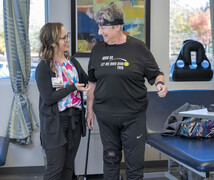Pro athletes go abroad for injections of stem cells from their abdominal fat. Now Duke orthopaedic specialists offer the therapy to patients and study its effectiveness.
Harnessing the Body’s Natural Healing
The human body has an amazing ability to heal itself. “You break your arm, and we don’t do anything other than put it in a cast,” said Duke sports medicine specialist Blake Boggess, DO. “You get a cut, and most of the time you don’t have to go to the doctor; your body repairs and regenerates.” Today, Dr. Boggess and his colleagues are working to apply the body’s own healing abilities to injuries such as ligament and cartilage tears, and conditions like osteoarthritis and plantar fasciitis.
One of the methods they’re studying involves removing a small amount of abdominal fat through liposuction, extracting stem cells from the fat, and injecting them directly where the healing is needed. “Stem cells are cells that can transform into different tissue categories,” said Duke sports medicine orthopaedic surgeon Claude T. Moorman III, MD. “The theory is that you can inject them into the muscle and expect them to turn into muscle cells. Or you might inject them into a joint and expect them to turn into cartilage.”
This type of stem cell therapy has been available in Europe for several years, and star athletes and celebrities have been known to travel there to get it. More recently, for-profit clinics across the U.S. have begun offering stem cell treatment for a variety of conditions. The FDA currently doesn’t regulate the treatment, because the cells come from the patient’s own body and are minimally processed, so there’s little risk of rejection.
How Effective Is Stem Cell Therapy?
Reports of the treatment’s effectiveness are promising but largely based on observations.
Duke foot and ankle orthopaedic surgeons have used stem cell therapy successfully on patients who’ve had plantar fasciitis -- a common heel pain condition -- for years and failed to get relief from all other nonsurgical treatments. Within a month many patients see improvement, and they continue to improve.
Drs. Moorman and Boggess have had similar success stories at the James R. Urbaniak, MD, Sports Sciences Institute. For more than a year, they and several colleagues have been providing stem cell treatment to patients, including some elite college and pro athletes.
“We’ve used it for partial rotator cuff tears or partial Achilles tendon tears or ulnar collateral ligament tears,” Dr. Boggess said. “We’ve seen tears and partial tears heal faster. We feel that patients have gotten better, faster with the stem cells.”
“I started doing these treatments on people in their 30s and 40s who had shoulder arthritis, who still wanted to be very active but didn’t want to have joint replacement yet,” said Dr. Moorman. “We’d usually do arthroscopic surgery to clean out the shoulder joint. But we were seeing a much more positive response when we also injected stem cells than if we just cleaned the joint.”
Not all patients have had good results. For example, Dr. Boggess said, “With mild to moderate arthritis, we’ve seen a difference. But I have not been impressed with the results in people with bone-on-bone osteoarthritis.” That’s when the disease has advanced to the point where the cartilage -- the protective tissue between the bones of a joint -- has worn completely away.
Duke Doctors Study Stem Cell Therapy’s Potential
Ultimately, said Dr. Boggess, “There’s a lot of anecdotal evidence, but we have not proven that this is good medicine.”
Duke orthopaedic specialists are working to help advance scientific understanding of the treatment. Foot and ankle specialists closely following the progress of the patients they've treated with stem cell therapy and hope to publish their results. Drs. Moorman and Boggess are doing similar follow-up with shoulder arthritis patients. And they are readying a randomized, placebo-controlled study of stem cell therapy for knee arthritis.
In addition, their team is working with Duke cell biologist Matthew Hilton, PhD, to investigate how the treatment works on the cellular level. “One theory is that, when we inject a fat graft of concentrated stem cells into a knee, there may be some substances in the fat graft that have anti-inflammatory properties,” said Dr. Moorman. The question is, which promotes the healing: the anti-inflammatory substances or the stem cells’ ability to turn into other types of tissue? “It could be either -- or both,” Dr. Moorman said.
Should You Consider Stem Cell Therapy?
Because of its unproven nature, stem cell therapy isn’t covered by insurance. For the same reason, Duke orthopaedic specialists generally provide it at-cost, as a way to offer a new treatment option while also studying its effectiveness.
The procedure does involve some risks -- generally the same risks that accompany any liposuction, joint surgery, or injection procedures. But for those who haven’t gotten relief from other treatment approaches and want to forestall joint replacement surgery or aren’t candidates for it, stem cell therapy may be an option to consider.






